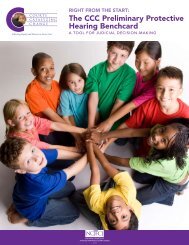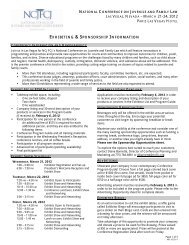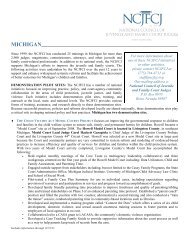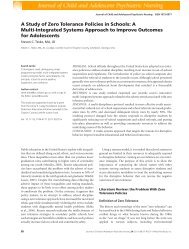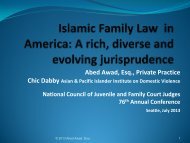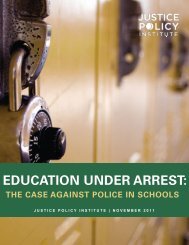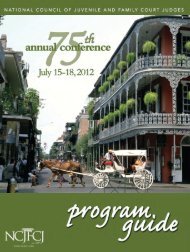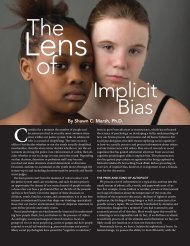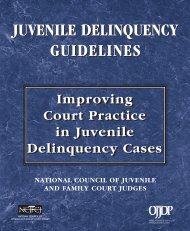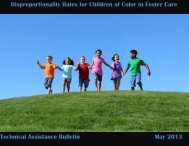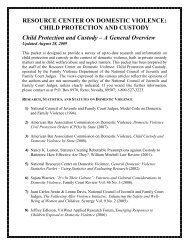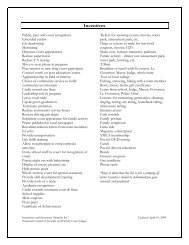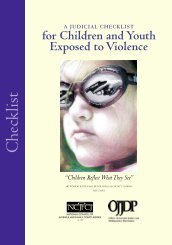dowNload - National Council of Juvenile and Family Court Judges
dowNload - National Council of Juvenile and Family Court Judges
dowNload - National Council of Juvenile and Family Court Judges
You also want an ePaper? Increase the reach of your titles
YUMPU automatically turns print PDFs into web optimized ePapers that Google loves.
OUR WORK<br />
One <strong>Family</strong>, One Judge:<br />
Unlocking the Ancient Mystery <strong>of</strong> How to Build an<br />
Evidence Base in <strong>Juvenile</strong> Dependency <strong>Court</strong>s<br />
By Alicia Summers, Ph.D.<br />
<strong>Judges</strong> are the gatekeepers <strong>of</strong> the juvenile dependency system, the<br />
ultimate decision-makers on child welfare cases, <strong>and</strong> determiners <strong>of</strong><br />
the fate <strong>of</strong> the children <strong>and</strong> families involved in the system. With this<br />
great power comes a great responsibility to make the most informed <strong>and</strong> best<br />
decisions possible for this child <strong>and</strong> this family, considering each family’s<br />
unique circumstances. The one family, one judge model <strong>of</strong> decision-making,<br />
whereby one judge oversees a case from the very first hearing to case closure,<br />
is a best practice that can enhance the decision-making ability <strong>of</strong> judges.<br />
Despite the belief that one family, one judge models may improve<br />
efficiency <strong>and</strong> lead to better decision-making, little has been done to<br />
examine the potential benefits <strong>of</strong> the model work out in real-world<br />
practice—until now. A recent collaboration between the Baltimore <strong>Juvenile</strong><br />
<strong>Court</strong>, the University <strong>of</strong> Maryl<strong>and</strong> School <strong>of</strong> Social Work (UMSSW), <strong>and</strong><br />
the NCJFCJ has led to a broad-based assessment <strong>of</strong> how one family, one<br />
judge programs might affect children <strong>and</strong> families.<br />
Planning for the assessment began shortly after the Baltimore City<br />
<strong>Juvenile</strong> <strong>Court</strong> became part <strong>of</strong> the Victims Act Model <strong>Court</strong> project with<br />
the inclusion <strong>of</strong> a local pr<strong>of</strong>essor on the Model <strong>Court</strong> executive team. From<br />
2009 to 2011, a series <strong>of</strong> multi-method assessments began to explore the<br />
use <strong>of</strong> the one family, one judge practice. Results from these studies are<br />
expected to be published during the next year in <strong>Family</strong> <strong>Court</strong> Review,<br />
<strong>Juvenile</strong> <strong>and</strong> <strong>Family</strong> <strong>Court</strong> Journal, <strong>and</strong> the Journal <strong>of</strong> <strong>Juvenile</strong> Justice.<br />
Why One <strong>Family</strong>, One Judge?<br />
Use <strong>of</strong> the one family, one judge system <strong>of</strong> oversight has long been<br />
recommended for <strong>and</strong> utilized within the juvenile dependency court<br />
system. Many <strong>of</strong> the NCJFCJ Model <strong>Court</strong>s, as well as other courts<br />
around the country, utilize some form <strong>of</strong> one family, one judge model.<br />
Proponents <strong>of</strong> the model believe it can increase the efficiency <strong>of</strong> case<br />
processing, <strong>and</strong> allow for more informed decision-making. <strong>Juvenile</strong><br />
dependency cases are complex <strong>and</strong> <strong>of</strong>ten lengthy, taking on average 13<br />
months to reach case closure. A one family, one judge model can help<br />
manage the complexities that are inherent in juvenile dependency cases.<br />
<strong>Judges</strong> who have the case from start to finish may feel a greater<br />
sense <strong>of</strong> ownership or responsibility, knowing that they will have it<br />
through to completion, whatever the outcome. Judicial consistency<br />
means that judges are more likely to have all the information on<br />
the case, from start to finish, which can help them underst<strong>and</strong> the<br />
special circumstances unique to the family appearing before them.<br />
This model may also serve to meaningfully engage the families in the<br />
process, as parents may feel more connected by seeing the same judge<br />
at every hearing.<br />
Evaluating One <strong>Family</strong>, One Judge<br />
The Baltimore <strong>Juvenile</strong> <strong>Court</strong> became an NCJFCJ Model <strong>Court</strong> in<br />
2005, creating a Model <strong>Court</strong> executive team to lead systems change<br />
efforts. Executive team collaboratives are encouraged to include key<br />
stakeholders <strong>and</strong> community partners.<br />
One <strong>of</strong> these community partners linked the executive team with<br />
a pr<strong>of</strong>essor from the University <strong>of</strong> Maryl<strong>and</strong>, School <strong>of</strong> Social Work,<br />
who became a major asset in evaluating court practice. The pr<strong>of</strong>essor<br />
spent the better part <strong>of</strong> a year meeting with the executive team <strong>and</strong><br />
26 JUVENILE AND FAMILY JUSTICE TODAY | WINTER 2013



